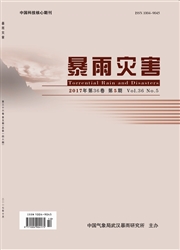

 中文摘要:
中文摘要:
This study investigates multi-model ensemble forecasts of track and intensity of tropical cyclones over the western Pacific, based on forecast outputs from the China Meteorological Administration, European Centre for Medium-Range Weather Forecasts, Japan Meteorological Agency and National Centers for Environmental Prediction in the THORPEX Interactive Grand Global Ensemble(TIGGE) datasets. The multi-model ensemble schemes, namely the bias-removed ensemble mean(BREM) and superensemble(SUP), are compared with the ensemble mean(EMN) and single-model forecasts. Moreover, a new model bias estimation scheme is investigated and applied to the BREM and SUP schemes. The results showed that, compared with single-model forecasts and EMN, the multi-model ensembles of the BREM and SUP schemes can have smaller errors in most cases. However, there were also circumstances where BREM was less skillful than EMN, indicating that using a time-averaged error as model bias is not optimal. A new model bias estimation scheme of the biweight mean is introduced. Through minimizing the negative influence of singular errors, this scheme can obtain a more accurate model bias estimation and improve the BREM forecast skill. The application of the biweight mean in the bias calculation of SUP also resulted in improved skill. The results indicate that the modification of multi-model ensemble schemes through this bias estimation method is feasible.
 英文摘要:
英文摘要:
This study investigates multi-model ensemble forecasts of track and intensity of tropical cyclones over the western Pacific, based on forecast outputs from the China Meteorological Administration, European Centre for Medi- um-Range Weather Forecasts, Japan Meteorological Agency and National Centers for Environmental Prediction in the THORPEX Interactive Grand Global Ensemble (TIGGE) datasets. The multi-model ensemble schemes, namely the bias-removed ensemble mean (BREM) and superensemble (SUP), are compared with the ensemble mean (EMN) and single-model forecasts. Moreover, a new model bias estimation scheme is investigated and applied to the BREM and SUP schemes. The results showed that, compared with single-model forecasts and EMN, the multi-model ensembles of the BREM and SUP schemes can have smaller errors in most cases. However, there were also circumstances where BREM was less skillful than EMN, indicating that using a time-averaged error as model bias is not optimal. A new model bias estimation scheme of the biweight mean is introduced. Through minimizing the negative influence of singu- lar errors, this scheme can obtain a more accurate model bias estimation and improve the BREM forecast skill. The ap- plication of the biweight mean in the bias calculation of SUP also resulted in improved skill. The results indicate that the modification of multi-model ensemble schemes through this bias estimation method is feasible.
 同期刊论文项目
同期刊论文项目
 同项目期刊论文
同项目期刊论文
 Study on Ensemble-Based Forecast of Extremely Heavy Rainfalls in China: Experiments for July 2011 Ca
Study on Ensemble-Based Forecast of Extremely Heavy Rainfalls in China: Experiments for July 2011 Ca 期刊信息
期刊信息
